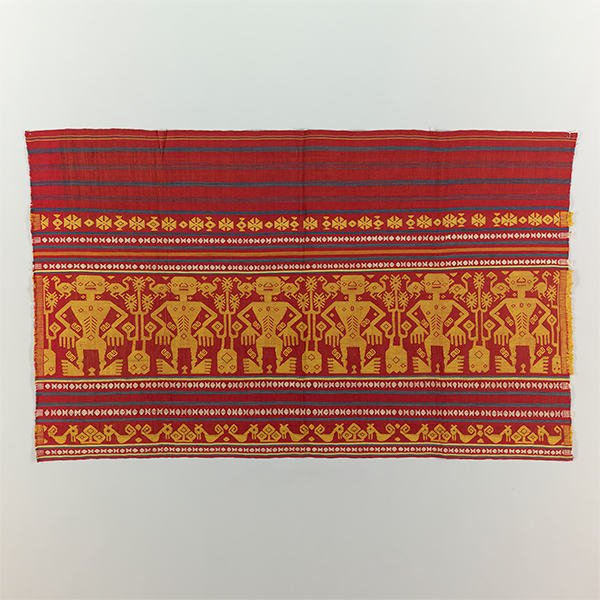アジアの染織 インドネシアの染織
-

ラウ・コンブ(腰衣)赤地縞人物鳥文様経浮紋織 インドネシア・スンバ島 20世紀半ば
東洋館 13室
2024年7月9日(火) ~ 2024年9月29日(日)多くの島々からなるインドネシアでは、各地域・民族で独自の染織文化を営んできました。チャンティンやチャップと呼ばれる金属製の筒や型で蝋防染を施し、繊細な文様を染め出すバティックをはじめ、儀礼用のイカットなど、用いられた技法・文様ともにその種類はさまざまです。本展では、19世紀から20世紀にかけて製作された染織品を、地域ごとに展示し、インドネシアの多様な織りと染めの世界を、作品の用途とともに紹介します。
| 指定 | 名称 | 員数 | 作者・出土・伝来 | 時代・年代世紀 | 所蔵者・寄贈者・列品番号 | 備考 | |
| おすすめ | ドドット 茶地ガルーダ文様バティック | 1枚 | インドネシア・ジャワ島中部 | 19世紀 | TI-280 | ||
| サロン(腰衣) 白木綿地スエズ運河オランダ海軍船文様バティック | 1枚 | インドネシア・ジャワ島北岸 | 19世紀末~20世紀初頭 | TI-618 | |||
| カイン・パンジャン(腰衣) ウダン・リリス文様印金バティック | 1枚 | インドネシア・ジャワ島・ラスム | 20世紀初頭 | TI-263 | |||
| プア・コンブ(肩衣) 茶地菱人物文様経絣 | 1枚 | マレーシア・ボルネオ島・サラワク | 20世紀 | TI-259 | |||
| バティック文様見本裂 | 11枚 | インドネシア・ジャワ島 | 20世紀 | TI-349-17 | |||
| おすすめ | パレパイ(霊船布) 人物船形文様縫取織 | 1枚 | インドネシア・スマトラ島・クロエ | 19~20世紀 | TI-511 | ||
| スレンダン 染分地花格子文様印金 | 1枚 | インドネシア・スマトラ島・パレンバン | 19世紀 | TI-267 | |||
| タピス(筒状衣) 縞地人物草花幾何文様ミラー刺繡 | 1枚 | インドネシア・スマトラ島・ランプン | 20世紀 | TI-160 | |||
| ショール 赤地花文様緯絣 | 1枚 | インドネシア・スマトラ島・パレンバン | 19世紀 | TI-196 | |||
| ウロス 紫地幾何文様浮紋織経絣 | 1枚 | インドネシア・スマトラ島・バタック族 | 19~20世紀 | TI-208 | |||
| 白地ヒンドゥー教説話文様描絵 | 1枚 | インドネシア・バリ島 | 20世紀 | TI-301 | |||
| 婚礼用衣装 赤茶地縞幾何文様経絣 | 1枚 | インドネシア・ロンブレン島 | 19世紀 | TI-358 | |||
| 儀礼用掛布 縞幾何文様経絣 | 1枚 | インドネシア・スラウェシ島 | 19世紀 | TI-362 | |||
| ショール 紺地草花文様経絣 | 1枚 | インドネシア・ロティ島 | 19~20世紀 | TI-255 | |||
| グリンシン(肩掛) ワヤン人形文様経緯絣銀糸刺繡 | 1枚 | インドネシア・バリ島・テンガナン | 19~20世紀 | TI-240 | |||
| おすすめ | ラウ・コンブ(腰衣) 赤地縞人物鳥文様経浮紋織 | 1枚 | インドネシア・スンバ島 | 20世紀半ば | TI-356 | ||
| 腰衣 縞地人物幾何文様経絣 | 1枚 | インドネシア・キサール島 | 19~20世紀 | TI-352 |
